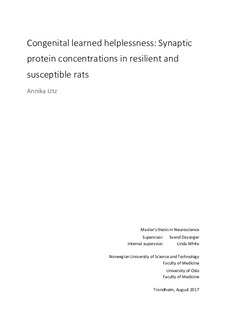Congenital learned helplessness: Synaptic protein concentrations in resilient and susceptible rats
Master thesis

Åpne
Permanent lenke
http://hdl.handle.net/11250/2584380Utgivelsesdato
2017Metadata
Vis full innførselSamlinger
Sammendrag
Hippocrates proposed that mental health is based on the balance of four bodily fluids, blood, black bile, yellow bile and phlegm. This theory of humorism has been discarded, but the idea, of physical changes accompanying psychological disorders still applies. Depression is fortunately no longer viewed as an excess of black bile. Nevertheless, how neurophysiology differs in depressed brains, compared to healthy ones, is still poorly investigated. Glutamatergic synapses, which provide the main excitatory input to neurons, might be implicated in depressive disorders. Ample evidence of glutamatergic dysfunction in depressed patients has been found in the hippocampus and prefrontal cortex. In addition, findings from resting state functional connectivity analyses implicate the anterior cingulate cortex (ACC) in depressive disorders. To analyze glutamatergic changes in the ACC in depression, relative concentrations of proteins with important functions in glutamatergic synapses were studied in an animal depression model. Two strains were compared, congenital helpless rats (cLH) and congenital non-helpless rats (cNLH). Additionally, the hippocampus was analyzed as a positive control, and the primary motor and somatosensory cortices as a negative controls. Surprisingly, the main difference between the two strains was found in the primary motor cortex. Here, a higher concentration of PSD95 was measured in cLH animals compared to cNLH. This increased concentration might be linked to a symptom of depressive disorders, namely psychomotor retardation.